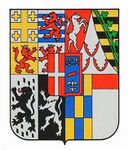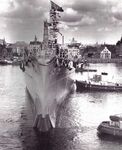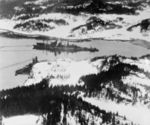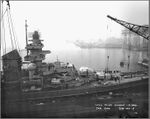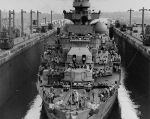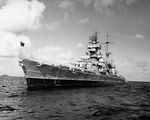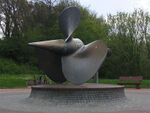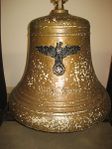Prinz Eugen
| Revision as of 19:14, 30 January 2017 | Revision as of 05:02, 27 February 2017 Various updates to Performance and Historical sections. Re-organized and updated Upgrades section. Updated Commander Skills for 0.6.0. Added Signal Flag table. Added Historical Gallery photos. | |||
| Line 6: | Line 6: | |||
| |Performance=<!-- write text about performance in battles below --> | |Performance=<!-- write text about performance in battles below --> | |||
| ? | ''Prinz Eugen'' is similar in many ways to her sister ship in the tech tree | + | ''Prinz Eugen'' is similar in many ways to her sister ship in the tech tree — ''[[Admiral Hipper]]'' — with identical guns, armor, and torpedoes. The guns are long range and have relatively flat trajectories, but with only eight of them and a low fire chance they can seem inadequate at times against tougher enemies. The torpedoes are the standard 6.0 km range, 13,700 damage G7a T1 torpedoes familiar to veterans of the German cruiser branch — mounted in two triple launchers per side just like ''Admiral Hipper'' — with fairly generous firing angles. She has very strong anti-aircraft defenses for her tier, similar to ''Hipper''’s Hull (C), but her rudder responds more slowly. Additionally, her detection range is notably worse than that of ''Admiral Hipper''... a full 0.7 km worse. | |
| + | ||||
| + | Overall, she is extremely similar to her sister and does not really bring anything new to the table. Captains who enjoy playing ''Admiral Hipper'' will find ''Prinz Eugen'' to be enjoyable and comfortable to play; captains who did not care for ''Hipper'' should avoid purchasing her. | |||
| '''[https://forum.worldofwarships.com/index.php?/topic/96790-premium-ship-review-prinz-eugen/ LittleWhiteMouse's Premium Ship Review: Prinz Eugen] from the NA forums''' | '''[https://forum.worldofwarships.com/index.php?/topic/96790-premium-ship-review-prinz-eugen/ LittleWhiteMouse's Premium Ship Review: Prinz Eugen] from the NA forums''' | |||
| Line 34: | Line 36: | |||
| |Upgrades=<!-- write text about best upgrades below --> | |Upgrades=<!-- write text about best upgrades below --> | |||
| + | Virtually all builds of ''Prinz Eugen'' find themselves mounting at least two upgrades in common: Main Armaments Modification 1 in [[Ship:Upgrades#Tier_I.2B_Equipment_.28Slot_1.29|Upgrade Slot 1]] and Damage Control System Modification 1 in [[Ship:Upgrades#Tier_III.2B_Equipment_.28Slot_4.29|Upgrade Slot 4]]. Steering Gears Modification 2 is typically taken in [[Ship:Upgrades#Tier_VI.2B_Equipment_.28Slot_5.29|Upgrade Slot 5]] to improve her handling. Concealment System Modification 1 is highly recommended in [[Ship:Upgrades#Tier_VIII.2B_Equipment_.28Slot_6.29|Upgrade Slot 6]] in order to help curtail her large detection radius. Combined with a captain with the Level 4 skill Concealment Expert, her detectability range drops under 12km. Conversely, Steering Gears Modification 3 is a strong option in Slot 6 for captains who prefer quicker rudder response. | |||
| + | ||||
| As with most cruisers, the upgrade in [[Ship:Upgrades#Tier_V.2B_Equipment_.28Slot_2.29|Upgrade Slot 2]] is what will differentiate one ''Prinz Eugen'' from another. | As with most cruisers, the upgrade in [[Ship:Upgrades#Tier_V.2B_Equipment_.28Slot_2.29|Upgrade Slot 2]] is what will differentiate one ''Prinz Eugen'' from another. | |||
| ? | The easy choice is Aiming Systems Modification 1, which improves her shell dispersion and provides a minor buff to her secondary battery | + | '''Generalist Build:''' The easy choice for Slot 2 is Aiming Systems Modification 1, which improves her shell dispersion and provides a minor buff to her secondary battery. This is the recommended pick for captains who don't wish to specialize the ship in anti-aircraft defenses. | |
| ? | + | |||
| ? | + | '''Anti-Aircraft Build:''' ''Prinz Eugen''’s already outstanding AA suite can be made even more potent by equipping AA Guns Modification 2, and maximized by assigning a captain with Advanced Firing Training. This pair of upgrades pushes the firing radius of her 105mm dual-purpose guns out to 6.5 km, providing excellent anti-aircraft protection for herself and teammates when utilizing [[Ship:Consumables#Defensive AA Fire|Defensive AA Fire]]. This does mean sacrificing the exceptional German [[Ship:Consumables#Hydroacoustic Search|Hydroacoustic Search]], however, and is a setup that is largely wasted in games without an aircraft carrier present. | ||
| |CommanderSkills= | |CommanderSkills= | |||
| ? | ''Prinz Eugen'' — like her sister ship, ''[[ | + | ''Prinz Eugen'' — like her sister ship, ''[[Admiral Hipper]]'' — prefers to hold opponents at arms' length. Brawling is not recommended unless the situation is heavily favorable, and the skills of her commander should be tailored to such a strategy. At this end of the German cruiser line the ships begin to play — and handle — more like small battleships, and players will frequently find their commander skill choices echoing those popularly found on battleships: Priority Target at Level 1 and Expert Marskman at Level 2. Concealment Expert is also highly recommended at Level 4, as is Advanced Firing Training for captains pursuing an '''Anti-Aircraft Build'''. Level 4 also offers Manual Control for AA Armament to captains wishing to go all-in on their '''Anti-Aircraft Build'''; this is a very strong skill for high-tier German cruisers and battleships due to the AA potency of their dual-purpose 105mm guns. | |
| ? | + | Level 3 is where captains are offered some customization in their build. Captains preferring the '''Anti-Aircraft Build''' will want to opt for Basic Firing Training. Those pursuing the '''Generalist Build''' are better off opting for Demolition Expert; Vigilance is also a decent choice. | ||
| {{Commander Skills | {{Commander Skills | |||
| ? | | Expert Loader=1 | + | | Priority Target = 3 | |
| ? | | | + | | Preventative Maintenance = 1 | |
| ? | | | + | | Expert Loader = 1 | |
| ? | | Expert | + | | Aircraft Servicing Expert = | |
| + | | Direction Center for Catapult Aircraft = 2 | |||
| + | | Dogfighting Expert = | |||
| + | | Incoming Fire Alert = 2 | |||
| + | | Evasive Maneuver = | |||
| ? | | Expert Marksman=3 | + | | High Alert = 2 | |
| ? | | Torpedo | + | | Jack of All Trades = 2 | |
| ? | | | + | | Expert Marksman = 3 | |
| ? | | | + | | Torpedo Acceleration = | |
| ? | | Last Stand=1 | + | | Smoke Screen Expert = | |
| + | | Expert Rear Gunner = | |||
| + | | Adrenaline Rush = 2 | |||
| + | | Last Stand = 1 | |||
| ? | | Torpedo | + | | Basics of Survivability = 1 | |
| ? | | | + | | Survivability Expert = 1 | |
| ? | | | + | | Torpedo Armament Expertise = | |
| ? | | | + | | Emergency Takeoff = | |
| ? | | | + | | Basic Firing Training = 2 | |
| + | | Superintendent = 1 | |||
| + | | Demolition Expert = 2 | |||
| + | | Vigilance = 2 | |||
| ? | | | + | | Manual Fire Control for Secondary Armament = | |
| ? | | | + | | Fire Prevention = 1 | |
| ? | + | | Inertia Fuse for HE Shells = | ||
| ? | | | + | | Air Supremacy = | |
| ? | | | + | | Advanced Firing Training = 3 | |
| ? | + | | Manual Fire Control for AA Armament = 2 | ||
| ? | | | + | | Radio Position Finding = | |
| ? | | Manual Fire Control for | + | | Concealment Expert = 3 | |
| ? | | | + | ||
| ? | | Concealment Expert=3 | + | ||
| ? | + | |||
| ? | + | |||
| }} | }} | |||
| ? | ||||
| |Consumables=<!-- write text about selection of Consumables below --> | |Consumables=<!-- write text about selection of Consumables below --> | |||
| Line 88: | Line 96: | |||
| |Signals=<!-- write text about best set of signals below --> | |Signals=<!-- write text about best set of signals below --> | |||
| + | ||||
| + | {{Signal Flags | |||
| + | | Hotel Yankee = | |||
| + | | Juliet Charlie = 1 | |||
| + | | November Foxtrot = 1 | |||
| + | | Zulu = 2 | |||
| + | | Juliet Yankee Bissotwo = | |||
| + | | India Delta = | |||
| + | ||||
| + | | India Yankee = | |||
| + | | November Echo Setteseven = 2 | |||
| + | | Zulu Hotel = 2 | |||
| + | | India Bravo Terrathree = | |||
| + | | Sierra Mike = 3 | |||
| + | | Victor Lima = 1 | |||
| + | ||||
| + | | Mike Yankee Soxisix = | |||
| + | | Papa Papa = | |||
| + | | India X-Ray = 1 | |||
| + | | Equal Speed Charlie London = | |||
| + | | Juliet Whiskey Unaone = | |||
| + | | Dragon Flag = 2 | |||
| + | }} | |||
| |Gallery=<!-- write below list of files with description (if necessary) separated with | --><gallery> | |Gallery=<!-- write below list of files with description (if necessary) separated with | --><gallery> | |||
| Line 93: | Line 124: | |||
| File:PEFires.jpg|''Prinz Eugen'' fires all its turrets in anger. | File:PEFires.jpg|''Prinz Eugen'' fires all its turrets in anger. | |||
| File:PEWaits.jpg|A pair of ''Prinz Eugen'' class cruisers sit at the entrance to the channel on Two Brothers, waiting for the right moment to strike. | File:PEWaits.jpg|A pair of ''Prinz Eugen'' class cruisers sit at the entrance to the channel on Two Brothers, waiting for the right moment to strike. | |||
| ? | File:PEKillsBismarck.jpg|In the ultimate betrayal, the ''Prinz Eugen'' torpedoes an enemy ''[[ | + | File:PEKillsBismarck.jpg|In the ultimate betrayal, the ''Prinz Eugen'' torpedoes an enemy ''[[Bismarck]]''-class battleship. | |
| </gallery> | </gallery> | |||
| Line 137: | Line 168: | |||
| ---- | ---- | |||
| ====Aircraft==== | ====Aircraft==== | |||
| ? | :Three Ar196 float planes, one catapult | + | :Three (3) Ar196 float planes, one catapult | |
| }} | }} | |||
| </div> | </div> | |||
| ===History=== | ===History=== | |||
| ====Design==== | ====Design==== | |||
| ? | The third ship in the ''[[Admiral Hipper]]'' class, the design for ''Prinz Eugen'' began under the limitations of the Treaty of Versailles. Because Germany was | + | The third ship in the ''[[Admiral Hipper]]'' class, the design for ''Prinz Eugen'' began under the limitations of the Treaty of Versailles. Because Germany was forbidden from constructing heavy cruisers under the limitations of the treaty, the actual building of such ships was — in the early 1930s — politically undesirable. Planning was, however, impossible to prevent, and a design commission was authorized. In June 1935, the Anglo-German Naval Treaty was signed and Germany was authorized to build ships within a 35:100 tonnage ratio to Britain, though Germany was still to remain under the restrictions enforced by the Treaty of Versailles. At the time, Royal Navy possessed total cruiser displacement of 146,800 tons, which provided the Germans an allotment of 51,380 tons for cruisers of their own. The justification for the ''Admiral Hipper'' class was to be found under the terms of the First London Naval Treaty which limited cruiser displacement to roughly 10,000 tons per ship for all signatory nations. Though Germany was not a signatory to the First London Naval Treaty, the restrictions under Versailles made the construction of heavy cruisers politically dangerous for Germany and cruisers over 10,000 tons even more so, thus construction of the planned five cruisers of the ''Admiral Hipper'' class was begun in secret until the abrogation of the Treaty of Versailles removed that necessity. | |
| ? | The design requirements for the ''Admiral Hipper | + | The design requirements for the ''Admiral Hipper'' class required the ships to be comparable to the French ''Algerie'' class, faster than the ''[[Dunkerque]]'' class, and capable of long range operations in the Atlantic Ocean, while still within 10,000 tons limit. While smaller, less politically dangerous designs with diesel or turbo-electric propulsion and 150mm to 190mm guns were initially considered, the final design settled on high pressure steam propulsion and 203mm guns. While the officially stated displacement would be 10,000 tons, the actual design displacement of the ''Admiral Hipper''-class would exceed 14,000 tons. | |
| Having settled the specifics of the design, the first two ships of the class, ''Admiral Hipper'' and ''Blücher'', were laid down in 1934 and 1935 respectively. ''Prinz Eugen'' was authorized in late 1935 along with two more ships, and laid down in the spring of the following year. Her construction started on 23 April 1936 in the Krupp-Germania Shipyard, Kiel. A slight difference in blueprints sent to dockyards resulted in a shorter hull of 205.9 m compared to 212.5 m of her sister-ships. | Having settled the specifics of the design, the first two ships of the class, ''Admiral Hipper'' and ''Blücher'', were laid down in 1934 and 1935 respectively. ''Prinz Eugen'' was authorized in late 1935 along with two more ships, and laid down in the spring of the following year. Her construction started on 23 April 1936 in the Krupp-Germania Shipyard, Kiel. A slight difference in blueprints sent to dockyards resulted in a shorter hull of 205.9 m compared to 212.5 m of her sister-ships. | |||
| Line 150: | Line 181: | |||
| ''Prinz Eugen'' received the benefit of experience in the construction and trials of her preceding sisters, and was completed with minor differences. At her launch on 22 August 1938, ''Prinz Eugen'' still featured a straight bow with triple anchors and open funnels. Before commissioning, she was drydocked to refit a clipper bow and capped funnels. She also possessed a rectangular bridge, larger hangar, and the two radar sets which became typical of the class. In a notable difference between ''Prinz Eugen'' and her preceding sisters, ''Prinz Eugen'' was also completed with her forward high angle directors exposed, the spherical covers being fitted a year later. Because of the incremental alterations to her basic design, ''Prinz Eugen'' measured 5 meters longer, 0.6 meter wider, 0.2 m deeper in draft and 200 tons heavier than ''Admiral Hipper'', while her standard displacement exceeded that of ''Admiral Hipper'' by 1,800 tons. | ''Prinz Eugen'' received the benefit of experience in the construction and trials of her preceding sisters, and was completed with minor differences. At her launch on 22 August 1938, ''Prinz Eugen'' still featured a straight bow with triple anchors and open funnels. Before commissioning, she was drydocked to refit a clipper bow and capped funnels. She also possessed a rectangular bridge, larger hangar, and the two radar sets which became typical of the class. In a notable difference between ''Prinz Eugen'' and her preceding sisters, ''Prinz Eugen'' was also completed with her forward high angle directors exposed, the spherical covers being fitted a year later. Because of the incremental alterations to her basic design, ''Prinz Eugen'' measured 5 meters longer, 0.6 meter wider, 0.2 m deeper in draft and 200 tons heavier than ''Admiral Hipper'', while her standard displacement exceeded that of ''Admiral Hipper'' by 1,800 tons. | |||
| ? | Because German capital ships generally followed similar design characteristics and arrangement of tower mast and funnels, they possessed a very similar appearance. The similarities between the ''Admiral Hipper'' class cruisers and ''Bismarck'' class | + | Because German capital ships generally followed similar design characteristics and arrangement of tower mast and funnels, they possessed a very similar appearance. The similarities between the ''Admiral Hipper'' class cruisers and ''Bismarck'' class battleships could, and did, confuse observers in poor visibility and without scale reference. On 24 May 1941, Admiral Holland aboard HMS ''Hood'' made just such an error, mistaking ''Prinz Eugen'' for ''[[Bismarck]]''. | |
| ? | ''Prinz Eugen'' was to receive multiple anti-aircraft modifications throughout her career, with new 20mm batteries being placed on the roofs of her | + | ''Prinz Eugen'' was to receive multiple anti-aircraft modifications throughout her career, with new 20mm batteries being placed on the roofs of her "Bruno" and "Caesar" turrets, as well as replacing landed searchlights (both forward and astride the funnel). Later plans to further augment her anti-aircraft complement with additional 20mm and 40mm guns were at least partially completed by the end of World War II. | |
| ''Prinz Eugen'' would, over time, become one of the most heavily sensor-equipped ships in German Navy. Throughout her career, multiple models of radars were equipped and replaced. These include FuMO 27 fitted at aft fire director in 1940; FuMO 27 fitted at foretop in 1940, which replaced by FuMO 26 in 1942; FuMO 25 fitted at mainmast in 1944; and FuMO 81 fitted at foremast in 1944. FuMB 1 passive radar detector also fitted in 1940 which later augmented by FuMB 4, FuMB 9, and FuMB 26 in 1944. | ''Prinz Eugen'' would, over time, become one of the most heavily sensor-equipped ships in German Navy. Throughout her career, multiple models of radars were equipped and replaced. These include FuMO 27 fitted at aft fire director in 1940; FuMO 27 fitted at foretop in 1940, which replaced by FuMO 26 in 1942; FuMO 25 fitted at mainmast in 1944; and FuMO 81 fitted at foremast in 1944. FuMB 1 passive radar detector also fitted in 1940 which later augmented by FuMB 4, FuMB 9, and FuMB 26 in 1944. | |||
| ? | A passive hydrophone system was installed aboard ''Prinz Eugen'' in August 1940. The equipment allowed her crews to listen to the acoustic signatures emitted by other ships to a maximum distance of 27 km even at maximum speed, | + | A passive hydrophone system was installed aboard ''Prinz Eugen'' in August 1940. The equipment allowed her crews to listen to the acoustic signatures emitted by other ships to a maximum distance of 27 km even at maximum speed, provided said ships were not obscured by her own acoustic shadow. | |
| ====Service==== | ====Service==== | |||
| Line 165: | Line 196: | |||
| While receiving repairs in Brest, ''Prinz Eugen'' was hit by a bomb during one of the Royal Air Force’s raid on the shipyard which destroyed her main control room, further delaying her return to service. Following several more bombings from the Royal Air Force, the German forces decided to relocate ''Prinz Eugen'' and the battleships ''[[Scharnhorst]]'' and ''[[Gneisenau]]'' through the English Channel and into safer shipyards. On the night of 11 February 1942, the three German vessels, accompanied by a flotilla of torpedo boats, embarked on their voyage through the dangerous English Channel. The German forces faced heavy fire from aircraft and coastal artillery units but managed to traverse the Channel with only minimal damage and arrived in Germany two nights later. | While receiving repairs in Brest, ''Prinz Eugen'' was hit by a bomb during one of the Royal Air Force’s raid on the shipyard which destroyed her main control room, further delaying her return to service. Following several more bombings from the Royal Air Force, the German forces decided to relocate ''Prinz Eugen'' and the battleships ''[[Scharnhorst]]'' and ''[[Gneisenau]]'' through the English Channel and into safer shipyards. On the night of 11 February 1942, the three German vessels, accompanied by a flotilla of torpedo boats, embarked on their voyage through the dangerous English Channel. The German forces faced heavy fire from aircraft and coastal artillery units but managed to traverse the Channel with only minimal damage and arrived in Germany two nights later. | |||
| ? | On 21 February 1942, ''Prinz Eugen'' accompanied by ''Admiral Scheer'' and several destroyers | + | On 21 February 1942, ''Prinz Eugen'' — accompanied by ''Admiral Scheer'' and several destroyers — departed from Germany on their voyage to Norway. While conducting patrol operations off the coast of Trondheimsfjord, ''Prinz Eugen'' was torpedoed by the British submarine HMS ''Trident''. The torpedo hit caused extensive damage to the ship’s stern and completely disabled her rudder. ''Prinz Eugen'' was towed to Lofjord where she received emergency repairs before returning to Germany in May to complete her repairs. | |
| In January 1943, ''Prinz Eugen'' was assigned to the Fleet Training Squadron in the Baltic Sea; however, she returned to combat service in October to help counter the Russian offense on the Eastern Front. Together with the heavy cruiser ''Lützow'', ''Prinz Eugen'' spent the greater part of 1943 and 1944 providing coastal support during the German withdrawal from Finland and the attempted invasion Hogland. The cruiser was again put out of service for repairs in October 1944 after ramming the light cruiser ''Leipzig''. By January 1945, the ship returned to providing coastal support until ''Lützow''’s sinking on 16 April. Four days later, ''Prinz Eugen'' arrived in Copenhagen where on 7 May, she was decommissioned and surrendered to the Royal Navy. | In January 1943, ''Prinz Eugen'' was assigned to the Fleet Training Squadron in the Baltic Sea; however, she returned to combat service in October to help counter the Russian offense on the Eastern Front. Together with the heavy cruiser ''Lützow'', ''Prinz Eugen'' spent the greater part of 1943 and 1944 providing coastal support during the German withdrawal from Finland and the attempted invasion Hogland. The cruiser was again put out of service for repairs in October 1944 after ramming the light cruiser ''Leipzig''. By January 1945, the ship returned to providing coastal support until ''Lützow''’s sinking on 16 April. Four days later, ''Prinz Eugen'' arrived in Copenhagen where on 7 May, she was decommissioned and surrendered to the Royal Navy. | |||
| ? | On 13 December 1945, ''Prinz Eugen'' was gifted to the United States as a war prize. Though the United States Navy | + | On 13 December 1945, ''Prinz Eugen'' was gifted to the United States as a war prize. Though the United States Navy was not interested in keeping the ship, they wanted to prevent Soviet Russia from acquiring it. As a result, the cruiser was commissioned as a miscellaneous vessel under the name USS ''Prinz Eugen''. The cruiser arrived in the Philadelphia Navy Yard in January 1946 where her radar and both guns from turret "Anton" were removed. The ship was then assigned to function as a target ship for Operation Crossroads in Bikini Atoll. ''Prinz Eugen'' survived both atomic detonations but was severely irradiated. After being towed to Kwajalein Atoll, the ship began to take on water and list heavily. Attempts were made to keep the vessel afloat, but all were unsuccessful. On 22 December 1946, the ship capsized in the shallow waters of the atoll where she remains visible today. | |
| ? | + | A number of artifacts from ''Prinz Eugen'' survive today. The US Navy salvaged one of her propellers in 1977, and presented it to the German Navy League in the summer of 1979. It is on display at the [https://deutscher-marinebund.de/ German Naval Memorial] in Laboe, Germany. The ship's bell was removed before she was sent to the Pacific to participate in Operation Crossroads; it resides in the collection of the [https://www.history.navy.mil/content/history/museums/nmusn.html National Museum of the United States Navy] and can be viewed in the Washington Navy Yard in Washington, DC. One of the guns removed from turret "Anton" prior to the ship being sent to the Pacific for Operation Crossroads remains in the archives of the Naval Surface Warfare Center ballistic testing facility in Dahlgren, Virginia. | ||
| |HistoricalGallery=<!-- write below list of files with description (if necessary) separated with | --><gallery> | |HistoricalGallery=<!-- write below list of files with description (if necessary) separated with | --><gallery> | |||
| + | File:Prinz_Eugen_crest.jpg|The crest of ''Prinz Eugen''. | |||
| File:Admiral Hipper ONI.jpg|US Office of Naval Intelligence recognition drawing of an ''Admiral Hipper''-class cruiser. | File:Admiral Hipper ONI.jpg|US Office of Naval Intelligence recognition drawing of an ''Admiral Hipper''-class cruiser. | |||
| File:Bundesarchiv DVM 10 Bild-23-63-14, Kiel, Kreuzer "Prinz Eugen", Stapellauf.jpg|Launching of ''Prinz Eugen'', 22 August 1938. | File:Bundesarchiv DVM 10 Bild-23-63-14, Kiel, Kreuzer "Prinz Eugen", Stapellauf.jpg|Launching of ''Prinz Eugen'', 22 August 1938. | |||
| + | File:Prinz_Eugen_launch.jpg|Launching of ''Prinz Eugen'', 22 August 1938. | |||
| File:Eugen2.jpg|''Prinz Eugen'' under fire during the Battle of the Denmark Strait, 20 May 1940. Photo taken aboard. | File:Eugen2.jpg|''Prinz Eugen'' under fire during the Battle of the Denmark Strait, 20 May 1940. Photo taken aboard. | |||
| + | File:Prinz_Eugen_at_Kiel.jpg|''Prinz Eugen'' moored at the Germania Werft Krupp yards in Kiel, autumn 1940. | |||
| File:Cruisers Admiral Scheer and Prinz Eugen at Lofjord 1942.jpg|''Prinz Eugen'' (center) under repair in the Lofjord; next to her, on her starboard side, is the repair ship ''Huascaran''; ''Admiral Scheer'' is also moored behind anti-torpedo nets. | File:Cruisers Admiral Scheer and Prinz Eugen at Lofjord 1942.jpg|''Prinz Eugen'' (center) under repair in the Lofjord; next to her, on her starboard side, is the repair ship ''Huascaran''; ''Admiral Scheer'' is also moored behind anti-torpedo nets. | |||
| File:Prinz Eugen2.jpg|''Prinz Eugen'' underway, date unknown. | File:Prinz Eugen2.jpg|''Prinz Eugen'' underway, date unknown. | |||
| File:Cruiser Prinz Eugen underway in May 1945.jpg|''Prinz Eugen'' under escort from Copenhagen to Wilhelmshaven after surrendering, May 1945. | File:Cruiser Prinz Eugen underway in May 1945.jpg|''Prinz Eugen'' under escort from Copenhagen to Wilhelmshaven after surrendering, May 1945. | |||
| ? | File:Prinz Eugen.jpg|''Prinz Eugen'' moored in Bikini Atoll during Operation Crossroads, June 1946. | + | File:Prinz_Eugen_at_Philly.jpg|USS ''Prinz Eugen'' docked at the Philadelphia Navy Yard in January 1946. The removal of the guns from turret "Anton" is underway. | |
| ? | File:Prinz_Eugen_prop.jpg|One of ''Prinz Eugen''’s propellers, salvaged from Kwajalein Atoll and on display at the German Naval Memorial in Laboe. | + | File:Prinz_Eugen_at_Panama.jpg|USS ''Prinz Eugen'' transiting the Gatun locks of the Panama Canal on her way to Bikini Atoll in the Pacific, 1946. | |
| ? | File:Prinz_Eugen_bell.jpg|''Prinz Eugen''’s bell, on display at the National Museum of the United States Navy in Washington, DC. | + | File:Prinz Eugen.jpg|USS ''Prinz Eugen'' moored in Bikini Atoll during Operation Crossroads, June 1946. | |
| + | File:Prinz_Eugen_prop.jpg|One of ''Prinz Eugen''’s propellers, salvaged from Kwajalein Atoll and on display at the [https://deutscher-marinebund.de/ German Naval Memorial] in Laboe. | |||
| + | File:Prinz_Eugen_bell.jpg|''Prinz Eugen''’s bell, on display at the [https://www.history.navy.mil/content/history/museums/nmusn.html National Museum of the United States Navy] in Washington, DC. | |||
| </gallery> | </gallery> | |||
Revision as of 05:02, 27 February 2017
[[File:<value_unset_error>_icon_small.png|<value_unset_error>|link=Ship:<value_unset_error>]] [[File:<value_unset_error>_icon_small.png|<value_unset_error>|link=Ship:<value_unset_error>]] [[File:<value_unset_error>_icon_small.png|<value_unset_error>|link=Ship:<value_unset_error>]] |
| File:icon small.png |
[[File:<value_unset_error>_icon_small.png|<value_unset_error>|link=Ship:<value_unset_error>]] [[File:<value_unset_error>_icon_small.png|<value_unset_error>|link=Ship:<value_unset_error>]] [[File:<value_unset_error>_icon_small.png|<value_unset_error>|link=Ship:<value_unset_error>]] |
| Maximum SpeedExpression error: Unexpected * operator. knot |
[[Ship:|]] — N/A special premium Tier N/A.
One of a series of Admiral Hipper-class ships and one of the most powerful heavy cruisers of the 1930s. During World War II, she was equipped with strong anti-aircraft guns and an enhanced fire control system.
Modules
Compatible Upgrades
| Slot 1 |
||||||||||||||||||||||||||||
|---|---|---|---|---|---|---|---|---|---|---|---|---|---|---|---|---|---|---|---|---|---|---|---|---|---|---|---|---|
| Slot 2 |
Damage Control System Modification 3 | |||||||||||||||||||||||||||
| Slot 3 |
||||||||||||||||||||||||||||
| Slot 4 |
||||||||||||||||||||||||||||
| Slot 5 |
Torpedo Tubes Modification 3 |
Reinforced Bulkheads | ||||||||||||||||||||||||||
| Slot 6 |
Player Opinion
Performance
Prinz Eugen is similar in many ways to her sister ship in the tech tree — Admiral Hipper — with identical guns, armor, and torpedoes. The guns are long range and have relatively flat trajectories, but with only eight of them and a low fire chance they can seem inadequate at times against tougher enemies. The torpedoes are the standard 6.0 km range, 13,700 damage G7a T1 torpedoes familiar to veterans of the German cruiser branch — mounted in two triple launchers per side just like Admiral Hipper — with fairly generous firing angles. She has very strong anti-aircraft defenses for her tier, similar to Hipper’s Hull (C), but her rudder responds more slowly. Additionally, her detection range is notably worse than that of Admiral Hipper... a full 0.7 km worse.
Overall, she is extremely similar to her sister and does not really bring anything new to the table. Captains who enjoy playing Admiral Hipper will find Prinz Eugen to be enjoyable and comfortable to play; captains who did not care for Hipper should avoid purchasing her.
LittleWhiteMouse's Premium Ship Review: Prinz Eugen from the NA forums
Pros:
- Excellent rate of fire, main battery range and accuracy, and shell velocity.
- Top-of-the-line armor piercing rounds with excellent penetration, capable of punishing damage against beam-on targets regardless of class.
- Quick turret traverse speed.
- German armor scheme makes her resilient to damage when angled at medium and close ranges.
- Generous torpedo firing arcs.
- One of the best anti-aircraft suites in her tier (only Mikhail Kutuzov is better).
Cons:
- Large turning radius.
- Poor stealth characteristics; she has a very large detectability radius, and will draw a lot of long-range fire from enemy ships in her stock configuration.
- Mediocre performance from her high-explosive shells.
- Can struggle to do damage against angled targets (due to HE shell performance).
- Average top speed; most other Tier VIII ships can keep up with her or simply run her down.
- Exceptionally vulnerable to long-range plunging fire.
Research
Optimal Configuration
Upgrades
Virtually all builds of Prinz Eugen find themselves mounting at least two upgrades in common: Main Armaments Modification 1 in Upgrade Slot 1 and Damage Control System Modification 1 in Upgrade Slot 4. Steering Gears Modification 2 is typically taken in Upgrade Slot 5 to improve her handling. Concealment System Modification 1 is highly recommended in Upgrade Slot 6 in order to help curtail her large detection radius. Combined with a captain with the Level 4 skill Concealment Expert, her detectability range drops under 12km. Conversely, Steering Gears Modification 3 is a strong option in Slot 6 for captains who prefer quicker rudder response.
As with most cruisers, the upgrade in Upgrade Slot 2 is what will differentiate one Prinz Eugen from another.
Generalist Build: The easy choice for Slot 2 is Aiming Systems Modification 1, which improves her shell dispersion and provides a minor buff to her secondary battery. This is the recommended pick for captains who don't wish to specialize the ship in anti-aircraft defenses.
Anti-Aircraft Build: Prinz Eugen’s already outstanding AA suite can be made even more potent by equipping AA Guns Modification 2, and maximized by assigning a captain with Advanced Firing Training. This pair of upgrades pushes the firing radius of her 105mm dual-purpose guns out to 6.5 km, providing excellent anti-aircraft protection for herself and teammates when utilizing Defensive AA Fire. This does mean sacrificing the exceptional German Hydroacoustic Search, however, and is a setup that is largely wasted in games without an aircraft carrier present.
Commander Skills
Prinz Eugen — like her sister ship, Admiral Hipper — prefers to hold opponents at arms' length. Brawling is not recommended unless the situation is heavily favorable, and the skills of her commander should be tailored to such a strategy. At this end of the German cruiser line the ships begin to play — and handle — more like small battleships, and players will frequently find their commander skill choices echoing those popularly found on battleships: Priority Target at Level 1 and Expert Marskman at Level 2. Concealment Expert is also highly recommended at Level 4, as is Advanced Firing Training for captains pursuing an Anti-Aircraft Build. Level 4 also offers Manual Control for AA Armament to captains wishing to go all-in on their Anti-Aircraft Build; this is a very strong skill for high-tier German cruisers and battleships due to the AA potency of their dual-purpose 105mm guns.
Level 3 is where captains are offered some customization in their build. Captains preferring the Anti-Aircraft Build will want to opt for Basic Firing Training. Those pursuing the Generalist Build are better off opting for Demolition Expert; Vigilance is also a decent choice.
| Recommended Commander Skills | ||||||||
|---|---|---|---|---|---|---|---|---|
| Cost (points) |
Endurance | Attack | Support | Versatility | ||||
| 1 |
★★★ |
★ |
★ |
|
|
|
★★ |
|
| 2 |
★★ |
★★ |
★★★ |
|
|
|
★★ |
★ |
| 3 |
★ |
★ |
|
|
★★ |
★ |
★★ |
★★ |
| 4 |
|
★ |
|
|
★★★ |
|
|
★★★ |
| Key: ★★★ - Extremely Useful ★★ - Frequently Useful ★ - Occasionally Useful No stars - Meh Χ - Not recommended | ||||||||
Camouflage
As a premium ship, Prinz Eugen comes included with Type 30 camouflage that is unique to her. It lowers her detection radius, reduces the accuracy of incoming shells, increases the amount of experience she earns, and provides an additional bonus to the experience earned by her commander.
An alternate Adler camouflage is available for purchase as well, with the added bonus of increasing her credit earnings by 10%.
Signals
Recommended Signal Flags 
| |||||
|---|---|---|---|---|---|
| Combat | |||||
 ★ |

|

|

|
 ★ |
 ★ |

|

|
 ★★ |
 ★★★ |
 ★ |

|

|

| ||||
Note: Use of the Juliet Charlie signal makes detonation impossible.
Gallery
Prinz Eugen sets sail on Two Brothers.
In the ultimate betrayal, the Prinz Eugen torpedoes an enemy Bismarck-class battleship.
Historical Info
Historical Gallery
| Destroyers | |
| Cruisers | |
| Battleships | |
| Aircraft Carriers |
| Japan | |
| U.K. | |
| France | |
| U.S.S.R. | |
| U.S.A. | |
| Germany | |
| Pan-Asia | |
| Spain | |
| Europe | |
| Netherlands | |
| Italy | |
| Commonwealth | |
| Pan-America |




